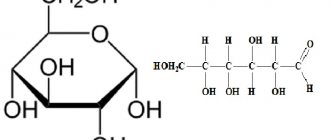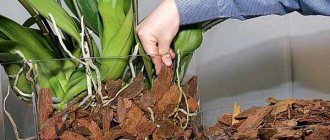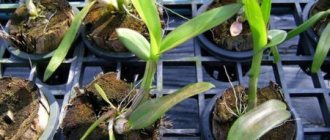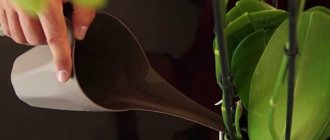A flowering plant such as an orchid is represented by a wide variety of varieties, but phalaenopsis is more adapted to growing at home. This plant is quite unpretentious and, if you care for it correctly, will bloom for about six months.
Proper care of phalaenopsis orchids means that you need not only to create optimal conditions for its maintenance and water it correctly, but also to carefully approach the issue of choosing and introducing fertilizer.
When to feed a phalaenopsis orchid?
The optimal time to fertilize a phalaenopsis orchid is 21-30 days after transplantation. To do this, they use special complex products, which include nutritional components and elements that stimulate the process of cell regeneration and activation of their growth. Succinic acid in the form of a solution, which is a growth regulator, is a good choice.
It is recommended that the first feeding of phalaenopsis at home be carried out using the foliar (leaf) method using spraying, since this way the plant will receive a larger amount of nutrients.
What is allowed and what is not?
The optimal choice is complex fertilizers, which have a special mark “for orchids”. You can also use complex mineral fertilizers for any indoor plants.
You cannot use tablets or sticks for phalaenopsis. This is explained by the fact that such substances will be unevenly distributed in the soil.
It is also impossible to control the volume and dosage. When choosing suitable products, be sure to take into account the effect of the components in the composition:
- nitrogen – activates growth;
- calcium – formation of buds, lush flowering;
- phosphorus is an essential part of protein and carbohydrate metabolism and is indispensable for young orchids.
Products used at home
Liquid fertilizers are better suited for orchids. You can also use powders for dilution in water. To make the right choice, you need to look at the ratio of nitrogen, phosphorus and potassium (indicated on the package). Nitrogen is designated by the letter N, phosphorus by P, and potassium by K.
For orchids, it is better to select a complex where potassium predominates in the composition . The next recommendation for the right choice is the Pn level. It should be neutral or slightly alkaline.
Chemical
The following is an overview of the best store-bought preparations for feeding phalaenopsis orchids.
- Bona Forte . A vitamin complex with a wide spectrum of action: increasing the flowering period, strengthening the immune system (the orchid becomes resistant to dry air, drafts, temperature changes), slowing down aging, improving photosynthesis.
- GreenWorld . Nutrient complex in liquid form. Benefits – strengthening roots and stems, improving leaf color and strength.
- Agricola. NPK 4-5-6 . Used for root feeding. Minus - there is no acidity indicator.
- Kemira Suite . Complex fertilizer, available in powder form. Pros: increased growth, reduced risk of disease, improved appearance. Cons – the composition is dominated by nitrogen.
- Pokon . Concentrated liquid. NPK – 5-6-7. Suitable for use at all stages of the growing season. Easy to digest. The purpose of application is the duration of flowering, the creation of bright green mass, better color intensity.
In addition to chemical elements, the orchid also requires biological additives. You can feed the flower with Baikal EM-1 (bacteria and yeast) or Epin (natural biostimulant).
Folk
The choice of folk products is huge. For feeding they usually use :
- potato broth;
- infusion of onion peel;
- infusion of wood ash.
Organic matter is also popular - manure, litter . Organic fertilizers for orchids cannot be used more than once every 4-6 months, since such compounds have a complex structure.
Other folk recipes should also be treated with caution, since the plant’s reaction to such components is unknown.
What fertilizer should I use?
When using fertilizer for phalaenopsis, you need to take into account the season. In winter and summer, the flower should be fed no more than once a month, and in autumn and spring - twice a month, provided that the orchid is not in the dormant stage.
There are special fertilizers for phalaenopsis orchids that contain the optimal amount of microelements, which allows you to avoid the salinity of the substrates.
If it is not possible to purchase such a fertilizer for phalaenopsis, then you can use the usual ones, which are intended for indoor flowers. It just needs to be less concentrated.
To improve the process of photosynthesis, as well as carbohydrate and protein metabolism for a phalaenopsis orchid, you should feed it with fertilizer containing phosphorus-containing substances. When entering the active growing season, the plant consumes many nutrients, due to which leaves and roots develop. For this reason, it requires large amounts of nitrogen-containing substances.
When choosing fertilizer for phalaenopsis, you need to remember such important microelements as potassium and phosphorus, which significantly affect the process of formation of buds and flower stalks. If there are enough of them, the color tone of the plant will become more pronounced, and the peduncle will develop well.
Principles of flower maintenance before and during the appearance of buds - what is the difference?
Care in these different periods is of course different, let's compare:
- Care before the peduncle is released - while the plant is resting (not blooming), it needs to be carefully looked after so that it has the strength to bloom for a long time:
You need to water as the roots dry out.- Maintain the required humidity and temperature.
- Lighting must be active.
- Carefully and regularly inspect the flower for pests.
- You should not get carried away with fertilizing, otherwise the Orchid may begin to “fatten”, grow leaves and roots, but not bloom.
If it still doesn’t bloom for a long time, you need to create “stress,” that is, create completely uncomfortable conditions: either move it to a darker place, or create a slight “drought” (dramatically reduce watering). After such actions, flower stalks usually appear.
Read also The mushroom turns red when cut
- Care during the release of the peduncle is no less thorough; of course, you need bright light, and the air humidity must be appropriate, the temperature regime must be observed, but after the peduncle has emerged, fertilizing should be immediately resumed at the required rate. At this moment they greatly influence the health of the entire Orchid bush in general and the quality of flowering in particular.
Do I need to fertilize during the flowering period?
During the flowering period, it is preferable to use purchased liquid fertilizers, which can significantly increase the lifespan of flower stalks and help the formation of new buds.
Before the plant begins to bloom, when the formation of peduncles is observed, additional feeding of the phalaenopsis orchid is necessary, since the flower at this time needs more nutrients.
Phalaenopsis fertilizer for flowering should be applied at least twice a week so that the orchid retains more vitality, this will have a beneficial effect on the buds. During the period of active flowering, during which almost all flower stalks have blossomed, feeding for phalaenopsis orchids is reduced. Now this should be done once a month. Active use of fertilizers can lead to accelerated flowering and stop the formation of new buds.
You may be interested in: How to care for orchids in a pot after purchase Why the leaves of an orchid wither and how to save it Features of the care and propagation of the Dendrobium Nobile orchid
If chemical or organic fertilizers have not been used before, there is no need to introduce such additives during the period when the plant has already bloomed.
Types of fertilizing
There are two types of fertilizing - foliar and root, but not everyone knows how to apply them correctly.
Root
The saturation of the orchid with root nutrition occurs only after watering it. Place the flower in a bowl with a nutrient solution for 15–25 minutes, during which time the roots will absorb the required amount of nutrients. After this, the orchid is removed and excess moisture is allowed to drain. The flower is placed in a warm place so that it can absorb the nutrients received.
Foliar
Orchids respond favorably to foliar feeding, since in this case the solution reaches all parts of the plant. You can spray the leaves through a spray bottle (mist jet mode) from bottom to top so that the solution covers the maximum area of the plant.
Important! Orchids should be sprayed in the evening, when the room temperature is not lower than +22
°
C. Lower temperatures often lead to the development of fungus, rot or mold on flower crops.
Why is it necessary to apply fertilizer only during the growth period?
Fertilizing should be applied only during the growth period, otherwise the fertilizer will not benefit the plant.
It makes no sense to feed a flower when it is in the dormant stage, and in some cases it is even dangerous - by introducing various means at the wrong time, you can activate the growth of phalaenopsis in an unnatural period for it. And frequent application of fertilizing will result in excessive leaf growth instead of the expected intensive flowering.
Improper care and its consequences
With proper care there should, in principle, be no difficulties or problems, but, unfortunately, this is not always the case:
- firstly, it is not always possible to create ideal conditions for the plant to send out flower stalks (read about why an orchid does not put out flower stalks and how to force it to do so);
- secondly, there is a problem in the lack of enough time for care.
Most often, the plant can be harmed by:
Spider mites - an unpleasant white coating appears on the leaves, a thin cobweb, it is noticeable along the edge of the leaf. This indicates insufficient air humidity; the flower needs to be thoroughly bathed in the shower (only warm), allowed to dry, and then treated with acaricides.- Scale insects are white in color and look like small white lumps on the leaves. You need to clean them off the leaves as soon as possible (you can use alcohol-soaked cotton wool) and then treat them with insecticides.
- Whitefly is a dangerous “butterfly” that can practically destroy a plant. You must first bathe it in a warm shower with laundry soap, and then also treat it with insecticides.
- Thrips are capable of infecting both leaves and flowers at once; they pierce the edges of the leaf with their proboscis and suck out the juice, the leaf begins to turn yellow. You urgently need to put the plant under the shower, thoroughly rinse each leaf and flowers, and then treat it with Aktara.
Read also How to close the second floor for the winter
The most common diseases due to improper care:
- Rot is a fungal disease; you must immediately remove the affected leaves and sprinkle the cuts with charcoal. The reason for this is a lot of moisture at low temperatures.
- Fusarium - the leaves soften and become covered with a pinkish coating, spots appear - treatment with Fundazol (within a week) will help. The reason is stagnation and too much air humidity.
- Powdery mildew - a white coating appears on the leaves and buds; treatment with a solution of colloidal sulfur or the drug "Skor" will help. The reason is the creation of a “greenhouse effect,” that is, too high a temperature and humidity.
- Spotting on leaves - the appearance of dark wet spots indicates that you are too carried away with fertilizing. The leaves will have to be removed and the flower treated with a fungicide.
How to feed phalaenopsis at home?
Fertilizers for phalaenopsis orchids can be introduced by two methods: root or foliar. With the first, the plant is fed in the morning for about half an hour after watering, due to which beneficial microelements quickly flow from the substrate to the roots. To do this, place the orchid in a solution with fertilizer for 15-20 minutes. Next, in order for the excess liquid to drain, you need to place it in a place where there is no draft. If there is a draft, the plant will rot. And only then put the flower pot in a permanent place.
But the foliar (leaf) feeding method is used more often. To avoid exposure to bright rays of the sun, which can cause burns, fertilize in the morning or evening.
The first stage is to carefully spray the roots on the surface and leaves with a special solution. In this case, you need to try not to touch the flowers and buds. This method is convenient for injured roots when there is a deficiency of micronutrients. When spraying a plant, you need to make sure that moisture does not remain in its rosette, otherwise it may rot.
Those who want to find the best fertilizer for phalaenopsis orchids should pay attention to the following concentrated fertilizers:
- "Agricola". This is a mineral fertilizer that was created specifically for feeding orchids. The introduction of the drug improves the appearance of the flower and helps it grow faster. The advantages of this product include ease of dosing and use, since it dissolves well in water.
- "Brexil Combi". This is a combined fertilizer that includes a large number of useful elements necessary if there is a deficiency of iron-containing substances in the flower.
- "Dr. Foley." This product is intended for foliar fertilizer. The advantages include ease of use, a large amount of vitamins, nutrients and essential acids.
- "Bona Forte". Liquid combined product intended for feeding orchids. Contains many substances that are necessary for normal plant growth. The fertilizer is easily diluted and has an affordable price.
- "Pokon." This feeding in the form of sticks is a product of a Dutch manufacturer. It is recommended to use twice a month. The product is convenient to use and the price is affordable.
- "Fasco". The fertilizer was created specifically for caring for orchids. The active components that are included in its composition contribute to the growth of leaves.
All of the above drugs provide effective nutrition. Before fertilizing phalaenopsis, you must carefully study the instructions and strictly follow all the recommendations specified in it.
Important ! An increased concentration of fertilizer in the substrate is considered very dangerous for all varieties of orchids. It is recommended to use 1 ml of feeding liquid per liter of water to prepare the solution.
The artificial introduction of fertilizing is not considered an important measure to ensure the growth and development of phalaenopsis. The flower itself can receive a significant amount of useful elements from the external environment. But, nevertheless, experts advise you to familiarize yourself with how to properly fertilize the phalaenopsis orchid in order to accelerate the growth of the plant and improve its flowering.
Precautions during operation
When applying fertilizers, there are certain rules that must be followed:
- root nutrition is applied only after the roots and substrate are saturated with moisture;
- do not feed the plant for a month after transplantation and after dormancy;
- Fertilizers are also not applied during flowering, as this shortens the duration of flowering;
- Only healthy plants are fed with fertilizing;
- the nutrient solution is not sprayed onto buds or flowers;
- it is necessary to strictly adhere to the dosage, not to exceed it, so as not to burn the root system or leaves of the phalaenopsis;
- Before using a complex aqueous solution, you need to shake the bottle, since beneficial salts tend to settle at the bottom;
- It is better to underfeed orchids with nutrients than to overfeed them;
- pay attention to the terms and conditions of storage of the drug.
Important! It is forbidden to apply foliar and root fertilizing at the same time; they can only be alternated.
Fertilizers are important for orchids, but they should be applied exactly when the plant needs them. If you follow simple rules for caring for a phalaenopsis orchid, it will respond with beautiful and long flowering.
Organic fertilizers for orchids
Organics are waste products of animals. It is not recommended to use it for feeding phalaenopsis - it is easy to burn the roots.
Organic fertilizers contain many macro and microelements and nutrients. But in its pure form this is too high a concentration. It is not used even for ordinary flowers. Only in diluted form. For phalaenopsis, organic matter is dangerous - the roots are too delicate. In addition, a high content of nitrogen compounds will destroy flower stalks.
Important! Instead of organic matter, it is useful to feed the orchid with succinic acid. One tablet is diluted in 1 liter of liquid and the plant is watered. To resuscitate a dying flower, use 4 tablets per liter of water.
About the importance of feeding orchids
Wild orchids are epiphytic flowers. They grow on other trees, but do not feed on their sap. Used as a support. Roots don't need soil. They are outdoor, airy. Like a sponge, they absorb nutrients from moisture and independently synthesize inorganic substances into organic ones.
Orchids
In nature, in the tropics, roots extract food from the environment. In home floriculture, they are provided with complex nutrition by fertilizers and fertilizing.











